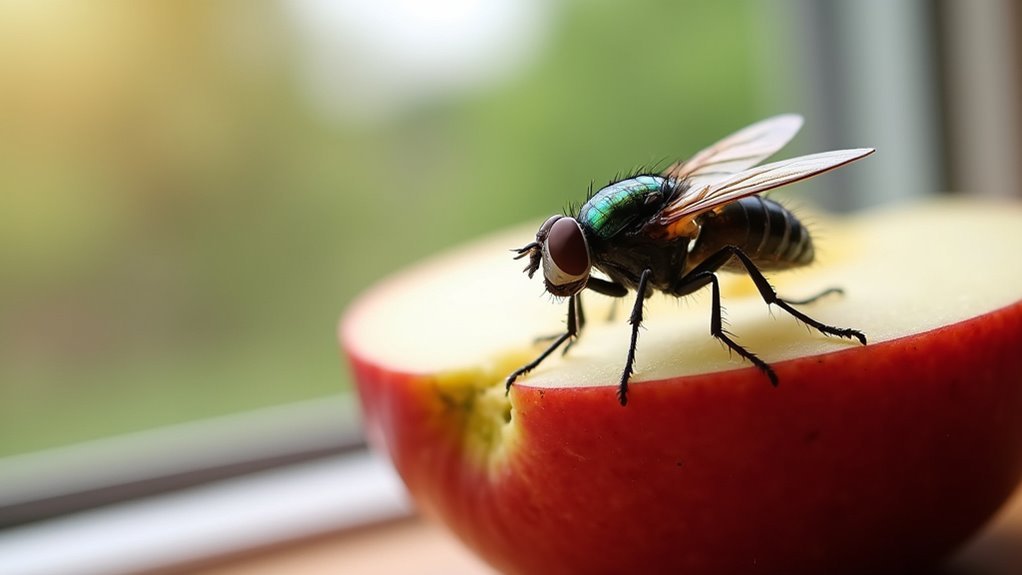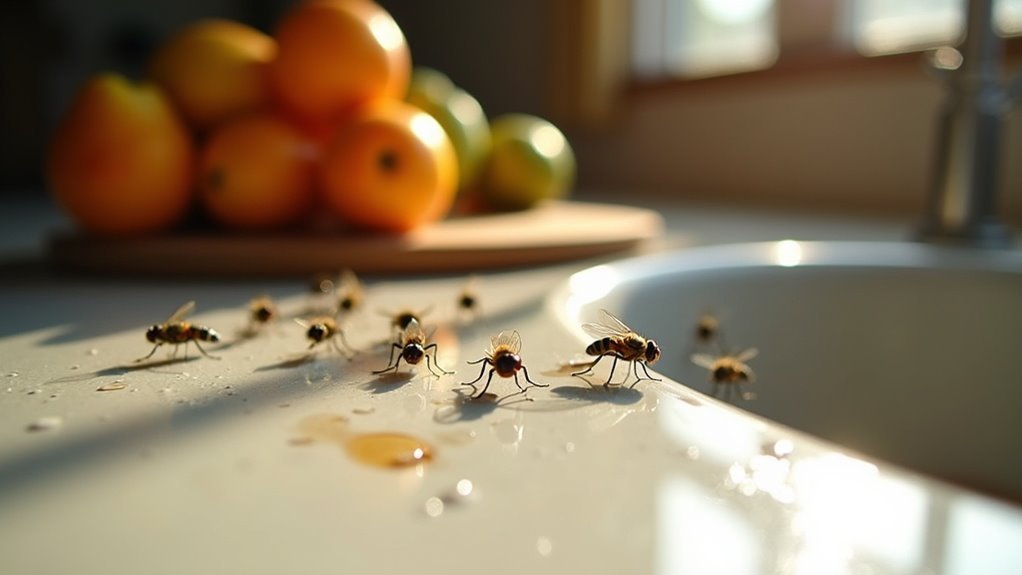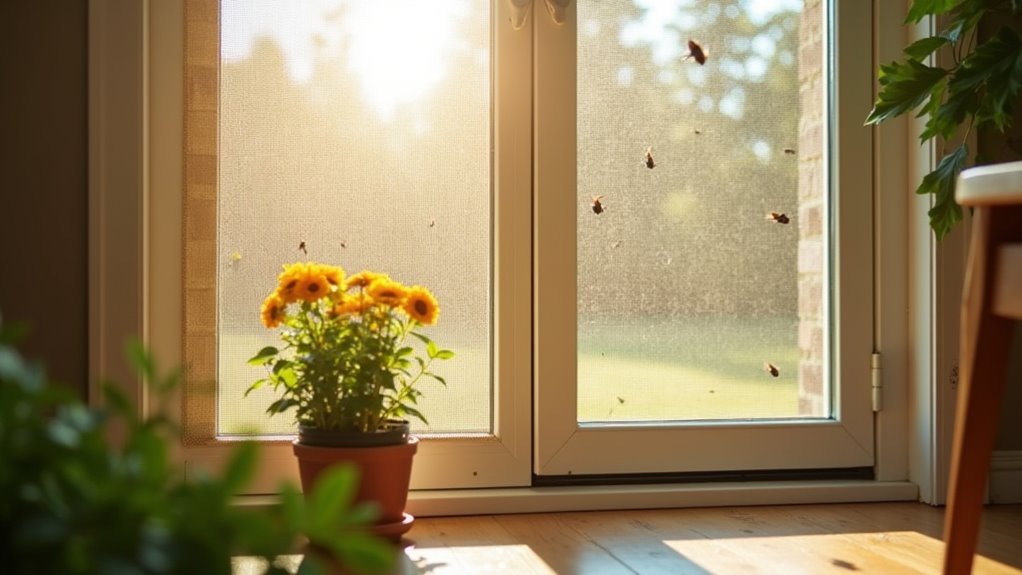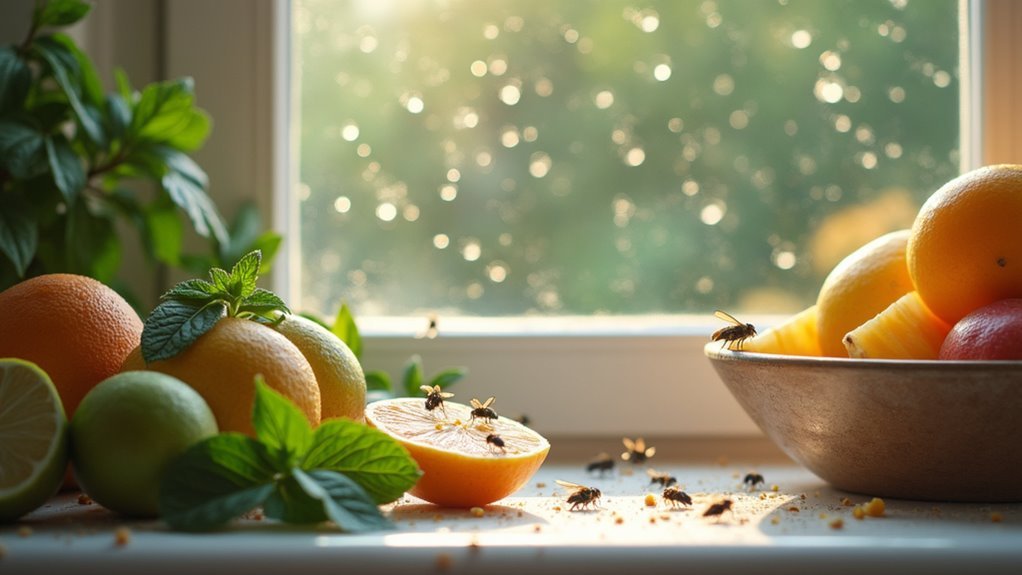Flies invade your home because they’re attracted to food odors, decaying organic matter, moisture, and warm indoor temperatures above 75°F that accelerate their breeding cycles. They’ll target garbage cans, overripe fruits, dirty drains, and any organic debris to establish colonies that can complete their life cycle in just 8 days. You can prevent infestations by maintaining spotless sanitation, storing food in airtight containers, eliminating moisture sources, and using physical barriers like screens on windows and doors to block their entry points and disrupt their reproduction cycles.
Common Types of Flies That Enter Homes

When flies invade your home, you’re likely encountering one of several common species that each have distinct characteristics and behaviors.
The common house fly appears gray and establishes breeding sites in decaying organic matter around your property.
You’ll notice fruit flies as tiny insects drawn to ripe or fermenting fruits in your kitchen.
Blow flies are larger with metallic coloring and indicate serious sanitation issues, often appearing near animal carcasses or rotting materials.
Cluster flies, known as “attic flies,” buzz around your windows during fall and spring while seeking indoor shelter.
Face flies resemble house flies but primarily affect livestock in rural areas.
Understanding these specific species helps you identify the source of fly infestations and implement targeted control strategies effectively.
What Attracts Flies to Your Living Space
After identifying the type of fly invading your home, you’ll want to understand what’s drawing them inside in the first place.
Flies are primarily attracted to decaying organic matter like rotting fruits, vegetables, and garbage. These materials serve as both a food source and ideal breeding sites where flies can lay up to 150 eggs at a time.
Your home’s temperature also plays an essential role. When indoor temperatures exceed 75 degrees Fahrenheit, fly larvae develop faster, creating larger populations.
Moist environments around over-watered plants or dirty drains attract fungus gnats and drain flies specifically.
Open doors and windows without screens provide easy access, especially when food odors drift outside and signal available resources to nearby flies.
Primary Breeding Sites and Moisture Sources

Once flies enter your home, they’ll quickly seek out breeding sites that provide the moisture and organic matter their larvae need to survive.
House flies target garbage cans, compost heaps, and areas with animal waste, where they can lay up to 150 eggs at a time.
Moisture sources create perfect environments for drain flies and fungus gnats – think leaking pipes, over-watered plants, and damp kitchen or bathroom areas.
Fruit flies gravitate toward overripe or fermenting produce, completing their life cycle in just 8 days.
Drain flies breed in organic material within your drains, thriving in sewage systems.
To prevent flies, you’ll need to eliminate these breeding sites by regularly removing organic debris and fixing moisture issues throughout your home.
Essential Sanitation Practices for Fly Prevention
Since effective fly prevention starts with breaking their breeding cycle, you’ll need to implement strict sanitation practices that eliminate food sources and moisture throughout your home.
Sanitation is the key to keeping flies away permanently.
Maintaining a spotless, moisture-free environment disrupts fly reproduction cycles and creates an inhospitable habitat that forces these pests to seek breeding grounds elsewhere.
Clean your kitchen regularly, focusing on garbage cans and food preparation surfaces where decaying organic matter accumulates. Store all food items, including fruits and vegetables, in airtight containers to prevent fly access. Dispose of garbage frequently using tightly sealed containers, then clean these containers to remove attracting residues.
Inspect and clean drains regularly to remove organic debris that creates breeding sites for drain flies. Control moisture levels throughout your home, particularly in basements and around over-watered plants, since excess humidity creates ideal conditions for fungus gnats and other small flies.
Physical Barriers and Exclusion Methods

While sanitation addresses the root causes of fly problems, physical barriers provide your first line of defense against flies attempting to enter your home.
These essential fly control measures create impenetrable boundaries that stop pests before they become indoor problems.
Effective physical barriers require strategic implementation at all potential entry points:
- Install tight-fitting window screens – Your windows become fortresses against unwanted invaders
- Seal cracks in doors, windows, and walls – Every gap you close is a victory against pest infiltration
- Use self-closing doors with door sweeps – Automatic protection that works even when you forget
- Maintain tidy outdoor areas – Remove decaying matter that attracts flies to your property’s perimeter
Regular inspection and repair of these barriers guarantees your home remains a fly-free sanctuary where your family can live comfortably.
Natural and Chemical Control Solutions
Even the most robust physical barriers benefit from additional support through targeted control solutions that actively repel and eliminate flies. Natural options include essential oils like lavender and eucalyptus, which effectively deter flies when applied strategically. You’ll find these work best when combined with thorough cleaning to eliminate breeding sites.
| Method Type | Solution | Application Area |
|---|---|---|
| Natural | Essential oils (lavender, eucalyptus) | Indoor deterrent zones |
| Trapping | Sticky paper/UV light traps | Away from food prep |
| Chemical | Pyrethrin aerosol sprays | Indoor temporary relief |
| Chemical | Residual pesticides | Outdoor resting surfaces |
| Targeted | Pesticide baits | Dumpsters/attraction sites |
Chemical control solutions include pyrethrin sprays for quick indoor results and residual pesticides for outdoor surfaces. Strategic placement of fly traps captures adults effectively, while pesticide baits target high-attraction areas like dumpsters.
Long-Term Maintenance Strategies for Fly-Free Homes
You’ll need to establish a year-round prevention system that adapts to seasonal fly activity patterns and changing weather conditions.
Regular monthly inspections of entry points, drainage areas, and potential breeding sites will help you catch problems before they become infestations.
Creating consistent environmental hygiene routines guarantees your home remains unattractive to flies regardless of external factors that might draw them to your property.
Seasonal Prevention Planning
Although flies can invade your home year-round, developing a seasonal prevention plan guarantees you stay ahead of their breeding cycles and peak activity periods.
You’ll need to conduct thorough seasonal inspections that identify potential fly entry points before flies become active. Your cleaning schedules should intensify during warmer months when breeding sites multiply rapidly.
Create an extensive seasonal checklist:
- Spring preparation – Inspect and seal cracks around doors and windows before fly populations explode
- Summer vigilance – Maintain weekly outdoor cleanup of decaying organic matter and garbage areas
- Fall protection – Remove overripe fruits and vegetables that attract late-season fruit flies
- Winter maintenance – Store food in airtight containers and address any structural vulnerabilities
This proactive approach prevents infestations rather than reacting to existing problems.
Regular Inspection Protocols
Since prevention remains only as effective as your vigilance, establishing regular inspection protocols creates the foundation for long-term fly control success.
You’ll need to conduct thorough inspections of kitchens, bathrooms, and outdoor areas to identify potential breeding sites like food debris, moisture, and decaying organic matter before indoor infestations develop.
Check your drains and plumbing systems for drain flies, cleaning them with stiff brushes and hot water to remove larvae-harboring buildup.
Inspect windows, doors, and vents for gaps that allow adult flies entry, sealing any cracks immediately.
Monitor indoor plants for overwatering, ensuring soil dries between waterings to prevent fungus gnat larvae.
Schedule seasonal inspections during early spring and late fall to address potential problems before they escalate into full-blown infestations.
Environmental Hygiene Systems
Building on your inspection routine, thorough environmental hygiene systems transform sporadic cleaning efforts into systematic maintenance that keeps flies away permanently.
Your environmental hygiene approach must target flies’ food preferences and eliminate breeding sites through consistent protocols:
- Kitchen sanitization – Deep clean food storage areas, countertops, and appliances weekly to remove organic residue that attracts flies.
- Waste management systems – Use sealed containers, clean bins regularly, and establish pickup schedules that prevent accumulation.
- Drain maintenance – Scrub kitchen and bathroom drains monthly to eliminate breeding sites for drain flies in unsanitary conditions.
- Outdoor area control – Monitor yards and gardens for decaying organic material, removing debris that creates fly-friendly environments.
These systematic practices create inhospitable conditions for flies, ensuring your home remains protected long-term.
Frequently Asked Questions
What Causes Flies to Invade Your House?
Flies invade your house because you’ve got decaying organic matter, warm temperatures above 75°F, excess moisture, and poorly sealed entry points like gaps in windows and doors that let them inside easily.
What Are the Ways of Preventing Flies?
You can prevent flies by maintaining cleanliness, securing windows with screens, sealing cracks, storing food in airtight containers, cleaning spills promptly, and managing outdoor areas by removing decaying matter.
What Is the Best Way to Keep House Flies Away?
You’ll keep house flies away best by maintaining strict cleanliness, removing waste promptly, securing windows with tight screens, storing food in airtight containers, and eliminating moisture sources that attract them.
Why Are Cluster Flies in My House All of a Sudden?
You’re seeing cluster flies because they’re emerging from hibernation in your walls or attic where they’ve been hiding all winter, seeking warmth and light as temperatures rise.
In Summary
You’ll keep flies out by maintaining clean surfaces, eliminating standing water, and sealing entry points. Don’t let garbage sit uncovered, and you should fix torn screens immediately. You can use natural repellents like essential oils or chemical sprays when needed. Remember that consistency matters most – you won’t see lasting results without regular cleaning routines. By combining sanitation, exclusion methods, and targeted treatments, you’ll create an environment that doesn’t welcome these persistent pests into your home.





Leave a Reply